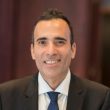Industry Spotlight on Selim Bouri, Airbus vice president and head of MENA and APAC
Selim, tell us a bit about yourself, and what interests you about working in public safety technology?
Even though I have a background in aerospace engineering, I have been working in the critical- and public-safety communications field for the past 17 years in Asia, Europe and the Middle East for various major professional radio players, such as Nortel Networks and Kapsch. Since January 2017, I have been the Global Head of Asia Pacific and the Middle East of Secure Land Communications at Airbus.
Working in the field of PMR is fascinating, because it is a very international business, and you have to adapt to various cultures simultaneously. Nevertheless, when it comes to public safety, there are certain universal values which define the requests in every region in the world—for example, how fast and efficient is a particular mission-critical communication technology, so it can save as many lives as possible? Such questions captivate me, as well as the fact that secure wireless communication is changing toward newer and better technologies.
Can you share your thoughts on the current state of the market? What excites you, what do you find concerning?
The incipient transition from a world of 2G to a future that will provide multimedia platforms in 4G and 5G networks for public safety is gorgeous and stimulating for industry. Clearly, the Middle East is one of the leading markets that demands the latest PMR technology, and this will have impact on other regions—but only if our industry keeps on setting global standards for the technology to come. I consider this as crucial to level the playing field for all companies in the market. As a result, public-safety users will be able to choose the best next-generation networks and devices to fulfill their daily work in a better way.
What is also key is that we are talking about far more than technology. The technology itself is only one (important) part of the equation, but the experience and the operational expertise behind the technology—to make sure the right usage behavior and operational procedures are implemented—are just as important, and this is why it is critical to work on this transition with experienced public-safety leaders.
No matter what technology we use, it will be always about securing critical operations and saving lives. This must be always our core priority to help our customers achieve that, and—in the end—protect all of us.
What is the one technology you [professionally] wouldn’t want to live without? Why?
People like me travel a lot and have to keep in touch with dozens of colleagues, partners, customers and family members at the same time. Wireless communication has changed my life for the better, because you can manage your projects and life, regardless of where you are and when you work. Although we all have used this mobile telecommunications technology for only about 10 years, it has become so compelling and natural to me since it has evolved.
In the past 5-10 years, what do you think has had the biggest impact on public safety?
The world of the Internet with its multimedia applications has changed public safety—and it will be increasingly impacting on the lives of police officers, firefighters and rescue services.
Why is that? Public safety is hungry for information when it comes to all sorts of incidents. Appropriate video and photo material helps them achieve their missions.
But we also realize that, no matter what new applications are introduced, being able to guarantee reliable and quality voice communication during a major crisis is—and will continue to be—a key application, and we shall never forget that protecting other people’s communication is key.
While we have seen the huge impact of CCTV and video on investigations, this need for reliable voice communications is why we at Airbus believe that hybrid is key when it comes to next-generation public-safety networks.
Are there any key learnings you’d like to share with the industry?
The entire Internet/multimedia/IT revolution has shown how quickly an industry can change. Former key players have been losing important market shares or even disappeared.
The ongoing technology change brings home the fact that the PMR industry has to adapt and set the foundation to meet the future needs. Consequently, the time has come to invest in R&D and develop new business models, while always keeping in mind that—and this is a major difference with the traditional telco sector—the most important characteristics are reliability and high availability
Is there anything you see happening in other sectors that you’d like to see used in public safety?
Being part of Airbus, the answer is easy. The aerospace sector’s certainty that there are no mental boundaries to explore new technologies is magnificent. Of course, the constraints of physical laws and limits of resources keep them modest, but this fuels the engineers’ creativity and joy to explore new technological solutions.
A pioneering spirit of this kind would help our industry to invent really new communications solutions for public safety. We are working on some new solutions that utilize a hybrid approach that we will be showcasing very soon.
Can you share a preview of what you’ll be discussing at Critical Communications MENA in September?
I expect debates on standardization and the management of hybrid networks, which is how we integrate LTE into existing TETRA networks. As a leading PMR provider, Airbus is involved in many PMR projects in the Middle East and worldwide. We can prove that we do not only speak about LTE, but we are really able to install technology that works reliably by incorporating existing TETRA infrastructure.
For more information about the Critical Communications MENA (Middle East North Africa) show on Sept. 25-26 in Dubai, visit https://tmt.knect365.com/critical-communications-mena/.















